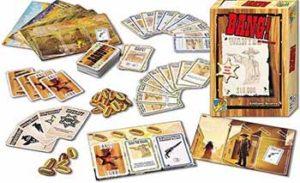For this balance-oriented critical play, I played the board game “Bang!” with four other friends in-person. “Bang!” is a card-based board game by Emiliano Sciarra that sets its players in the Wild Wild West. The players then get to choose a cowboy, get assigned a hidden role, and get to battle against the other players.
For formal elements, the game consists of Team vs Team style conflict that has an added twist of the roles being hidden. The Deputy protects the Sheriff and The Outlaws want to attack him. The Renegade wants to kill everyone else then the Sheriff. This makes the interactions between players very interesting and dynamic.

Now onto the most important part, the balance of the game:
“Balance between Strategies in a Game.”
There are multiple ways for each role to approach the game. For example, the Outlaws can outright rush the Sheriff at the start of the game to win. However, this is balanced out by the fact that the Sheriff starts with an extra “bullet” (life points). Furthermore, the Deputy and the Renegade will be forced to retaliate against the outlaws, since they both do not want the Sheriff to die early.
“Balance in Single-Player Games”
N/A
“Balance between Game Objects”
There are too main resources you have in the game: “Bullets” and cards. “Bullets” are balanced out so that the characters with stronger abilities have three “bullets”, while others have four. The cards on the other hand, are not very well balanced. For example, some special cards feel much more powerful than others, leading to very sudden lead changes and lopsided conflict. For example, the “Wells Fargo” card allows the user to draw 3 cards, which is a great amount of resource in the game.
“Balance in Asymmetric Games”
Since the players start out with different characters and roles. This game’s starting position is quite asymmetrical. It must be hard to balance out all of the character cards, and the role dynamics. Accordingly so, “Bang!” does a poor job of balancing out the different characters in the game. Some characters are blatantly overpowered than some of the other ones.
Three Ways to Balance Game Objects (Transitive, Intransitive, Fruity)
Transitive: To find desired proportion of costs to benefits in the game, the cards could be curved based on how they affect the player’s winrate and balance the number of cards through the benefits. For example, the “Wells Fargo” card would prob have a high win rate among players so the game could be balanced to have less.
Intransitive: The game has literally rock-paper-scissors system with “Bang!”, “Barrel”, “Duel!” cards and certain characters are good against certain characters but weak to others.
Fruity: For this game, a fruity approach to balancing might not be the best fit but there are possibilities. One way the game could be balanced is to introduce some characters with very niche playstyles and characteristics. Afterwards, playtesting multiple times and coming to a conclusion.


